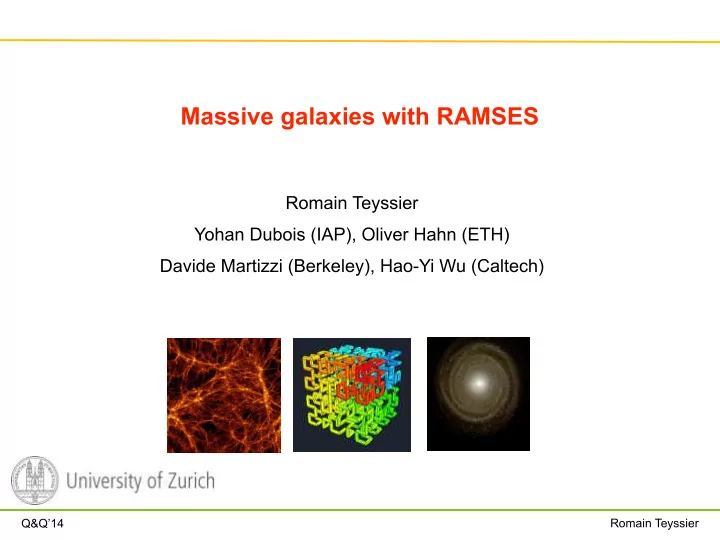

Massive galaxies with RAMSES Romain Teyssier Yohan Dubois (IAP), Oliver Hahn (ETH) Davide Martizzi (Berkeley), Hao-Yi Wu (Caltech) Q&Q’14 Romain Teyssier
Massive galaxies: the realm of AGN feedback Very low efficiency of gas conversion into star. Small mass galaxies are dominated by stellar feedback. Large mass galaxies are governed by AGN feedback. Stellar-to-halo mass ratio Moster et al. (2010) Dekel & Silk (1986) Silk & Rees (1998) Q&Q’14 Romain Teyssier
Precision computational cosmology Cosmological Simulation Working Group (Euclid Consortium) Q&Q’14 Romain Teyssier
Baryonic effects on weak lensing Model AGN feedback by removing gas below M crit Mohammed + , in prep Measuring the matter power spectrum using a pure dark matter theoretical model leads to a bias on the cosmological parameters. This bias could be as high as 10%, for a target precision < 1%. � Solution: use a theoretical model that includes baryonic effect. Error bars are increased but the bias is removed. Q&Q’14 Romain Teyssier
Scaling properties for massive haloes with RAMSES Martizzi + 14 Q&Q’14 Romain Teyssier
Scaling properties for massive haloes with AREPO Vogelsberger + 14 Q&Q’14 Romain Teyssier
Scaling properties for massive haloes with AREPO Genel + 14 Q&Q’14 Romain Teyssier
Baryonic effects on the mass function Martizzi + 14 Max-BCG or REFLEX eROSITA or EUCLID 0.5 (Gpc/h)^3 500 (Gpc/h)^3 Q&Q’14 Romain Teyssier
Galaxy formation on cluster scales Q&Q’14 Romain Teyssier
Feedback models from SMBH in massive ellipticals - Thermal feedback (Sijacki et al. 2007; Booth & Schaye 2010; Teyssier et al. 2010): “thermal bombs” - Radiative feedback (Choi et al, 2012, 2014; Vogelsberger et al. 2013): dust-absorbed UV radiation from the accretion disk. - Jet feedback (Omma et al., Cattaneo & Teyssier, Dubois et al. 2010, Choi et al. 2014): injection of momentum in a jet-like geometry. - Cosmic ray feedback (Pfrommer at al. 2010; Oh et al, 2013): heating from Alfven waves excited by CR-induced instabilities. - Bubble feedback (Sijacki et al. 2007): buoyantly rising bubble with initial radius close to 50 kpc � These models are related to the quasar mode (thermal, radiative) or to the radio mode (jet, CR, bubbles) of AGNs. Class of simulations: cosmological simulations with zoom-in or periodic boxes and around 1 kpc resolution. Q&Q’14 Romain Teyssier
The thermal feedback model in RAMSES. Numerical implementation in cosmological simulations: Sijacki et al. 2007; Booth & Schaye 2010 and many others. In high density regions with stellar 3D velocity dispersion > 100 km/s, we create a seed BH of mass 10 5 M sol . Accretion on a sink particle is governed by 2 regimes: � Bondi-Hoyle regime � Eddington-limited � Feedback performed using a thermal dump � with following trick to avoid overcooling: � Free parameter epsilon_c calibrated on the M-sigma relation. Q&Q’14 Romain Teyssier
AGN feedback: calibrating the coupling efficiency Dubois at al. (2012) Q&Q’14 Romain Teyssier
BCG properties Q&Q’14 Romain Teyssier
AGN feedback modifies the BCG properties Martizzi + 13,14 Booth & Schaye 10; Teyssier+10; Sembolini+11; Dubois+10,11; Martizzi + 11 Q&Q’14 Romain Teyssier
Stellar conversion efficiency with RAMSES Martizzi + 14 Q&Q’14 Romain Teyssier
Stellar conversion efficiency with GADGET Ragone-Figueroa+ 2013 Q&Q’14 Romain Teyssier
Stellar conversion efficiency with AREPO Genel+ 2014 Kravtsov+2014 Q&Q’14 Romain Teyssier
The structure of elliptical galaxies Faber et al. 1997 Q&Q’14 Romain Teyssier
A stellar core in massive elliptical galaxies ? Core elliptical: light deficit, low ellipticity, slow rotator Kormendy et al. 2009 core size ~ 0.5 kpc core size ~ 3 kpc Q&Q’14 Romain Teyssier
Structural properties of the BCG AGN-driven core formation core size ~ 6 kpc Martizzi et al. 2011 Q&Q’14 Romain Teyssier
Structural properties of the BCG ICL consistent with observations Martizzi + 14 Q&Q’14 Romain Teyssier
X-ray properties in the core Dubois + 12 AGN OFF AGN ON Cool core cluster with jet-feedback and zero metallicity cooling Q&Q’14 Romain Teyssier
The RAPHSODY-GAS simulation suite dark matter X-ray gas stars 2 Mpc/h Unique set to address both cosmological observables and the formation of clusters and galaxy members and in its outskirts goal: confront astrophysical models with full � multi-wavelength data available � ICs will be made public for community comparisons Hahn+(2014, in prep) Q&Q’14 Romain Teyssier
Does our AGN recipe fail for very massive galaxies ? 10 14 10 13 M ∗ , tot / M � 10 12 10 11 KVM 2014 - w/o scatter KVM 2014 - w scatter z = 0 - 4K 10 10 10 14 10 15 M 200c / M � Q&Q’14 Romain Teyssier
Does our AGN recipe fail for very massive galaxies ? BCG sizes BCG velocity disperson � Martizzi, Hahn+(2014, in prep) Q&Q’14 Romain Teyssier
Stellar metallicity in massive galaxies Normal yields High yields Stellar metallicities are too low Q&Q’14 Romain Teyssier
Conclusions - AGN feedback regulates the star formation efficiency in massive BCGs - AGN feedback reproduces scaling relations of BCG and the host clusters (AM, size, vel. disp.) for clusters around 10^14 Msol. - Is the model failing for massive clusters (M > 10^15 Msol) ? - AGN feedback reproduces the internal structure of BCG (inner core, Sersic profiles, outer regions and ICL). - Predicted X-ray properties are not robust (cool core versus entropy floor). - Key difficulty: efficiency of AGN feedback for various halo masses - Different implementations of AGN feedback lead to different and sometimes contradictory results: stellar-mass-to-halo-mass relations, gas fraction, effect on the total mass distribution … - Our AGN feedback models basically push gas out: similar to dwarf galaxies. Resulting metallicity is too low. Q&Q’14 Romain Teyssier
Recommend
More recommend